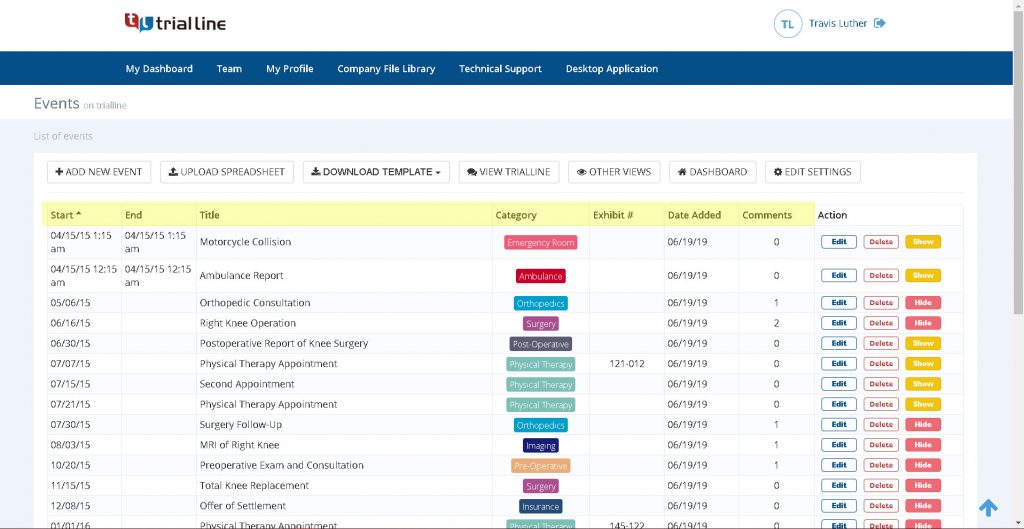Many parents involved in child custody battles often ask, “How long does a custody battle take?”
The answer depends on many factors, including the complexity of the custody case, cooperation between parents, and family court schedules.
Some child custody cases resolve in a few weeks with a quick settlement, while others can take months or years, especially when issues like primary custody, child support, or visitation rights are contested.
This blog post explains the factors affecting custody battles and discusses how understanding the family law process results in the best possible outcome for the children involved.
Take control of the custody case today. Try TrialLine for a smoother path to resolution!
Factors That Affect How Long Child Custody Battles Take
Child custody cases involve multiple stages, starting with filing the case, attending the first custody hearing, and waiting for the judge’s decision on the final order.
In some situations, the court may grant temporary custody while the case continues.
However, when one of the parents pursues full custody, the process may take longer, especially if compelling reasons or extra evidence are required.
The length of a custody battle depends on many factors:
Complexity of the Custody Case
Cases where both parents agree on primary custody, visitation rights, and child support typically move faster.
When the other parent contests key issues or when circumstances, such as relocation disputes or safety concerns arise, the case becomes more complex.
Such disputes often require additional evidence, expert testimony, and multiple court appearances, all of which extend the timeline.
Level of Conflict Between Parents

High-conflict child custody battles tend to last longer. When parents cannot agree on visitation, child support, or who will have primary custody, the court schedules additional hearings.
The first hearing sets the stage for the case, but repeated disagreements between parents can stretch the process over months or even years.
Cooperation between parents can greatly shorten the timeline by reducing the need for prolonged litigation.
Court Schedules and Availability
The availability of family court affects how long a custody battle takes.
Courts handle heavy caseloads in some areas, leading to long waits between the first hearing and the final order.
The judge may not have open dates for months, especially if the case requires multiple hearings due to some circumstances that demand closer examination.
Involvement of Third Parties
For some cases, the court may appoint third parties such as a guardian ad litem, social worker, or psychologist to evaluate what is in the children’s best interests.
These evaluations require time, sometimes months, especially when gathering reports or interviewing witnesses.
The findings from these evaluations can significantly influence the judge’s decision but also add to the overall timeline.
Keep your custody case on the right track with TrialLine!
Timelines for Child Custody Cases
The length of a child custody case depends on whether the parents can reach an agreement or if the case requires litigation.
When both parents agree on custody and visitation terms, the process only takes a few weeks or months. However, if there is a dispute over custody, the case can go on for several months to even years.
Court schedules, case complexity, and legal procedures all impact how long a case will take.
Some custody cases require immediate action, while others follow a standard legal process. The timeline varies based on the urgency of the situation and the need for additional evaluations, investigations, or hearings.
- Emergency custody cases (ex parte custody) – Filed to protect a child, these are usually resolved within 30 days. If a commissioner hears the case first, a rehearing by a judge can extend it to 45 days. An appeal may add at least three more months.
- Non-emergency custody cases – Typically up to six months to over a year. Delays occur if the court orders evaluations, drug testing, or a special setting, which can add up to six more months. Court-appointed professionals, such as a guardian ad litem or psychologist, may also extend the timeline.
How a Timeline Can Speed Up a Custody Case
With multiple hearings, deadlines, and court procedures, staying organized helps parents manage the process. A well-structured timeline keeps track of progress, reduces stress, and ensures that no critical steps are missed.
Organizing Evidence
A timeline helps organize and present evidence related to critical events or incidents that affect the case.
Placing these events in chronological order makes it easier for the court to understand how they impacted the child’s best interests. The timeline can outline:
- The birth of the child and the early involvement of each parent
- The start of a parent’s regular participation in the child’s life, such as attending school events or doctor appointments
- Certain circumstances like incidents of abuse, neglect, or unsafe living conditions
- Changes in living arrangements or employment that could affect child custody decisions
- Communication records that show cooperation or lack thereof between parents regarding visitation and daily care
Presenting these events clearly makes it easier for the court to understand the full context, strengthening a parent’s case.
Establishing Credibility
A well-documented timeline helps establish credibility, especially when parents provide conflicting stories.
The court values consistency and accuracy, particularly when supported by evidence. A timeline supports credibility through:
- Detailed descriptions of key events supported by documentation, such as medical records, report cards, or financial statements
- Clear proof of a parent’s consistent involvement in the child’s upbringing
- Dates and times of relevant incidents that show a parent acted responsibly and with the child’s best interests in mind
- Verified reports from third parties, like teachers or healthcare providers, that align with the timeline
When a timeline matches documented proof, the judge is more likely to view that parent as a reliable and truthful witness.
Focusing the Case
A timeline helps prevent a custody case from becoming bogged down with irrelevant details. It directs attention to key issues that affect the judge’s decision and the child’s best interests.
A focused timeline can:
- Identify significant events that directly impact custody decisions, such as the first hearing, custody evaluations, or school-related matters
- Help the attorney build strong arguments centered on facts that influence the outcome
- Prevent distractions from minor issues that do not affect the child’s welfare
- Highlight specific incidents that demonstrate why one parent may be more fitting for primary or full custody
Focusing on these points saves time, reduces legal expenses, and helps reach a decision faster.
Supporting a Settlement
Many custody battles end in settlement rather than trial.
A timeline helps both parents to settle sooner when it clearly presents the strengths and weaknesses of each case. It supports settlement negotiations when it:
- Highlights the consistent involvement of one parent in key aspects of the child’s life, such as education, healthcare, and daily routines
- Shows areas of potential compromise, such as shared visitation during holidays or special events
- Offers a neutral, fact-based presentation of events that reduces emotional conflict between parents
- Helps both parties understand how a judge might rule based on the documented history, prompting realistic expectations and agreements
A clear and well-documented timeline often persuades the other parent to agree to a custody arrangement that benefits the child without prolonged court battles.
Present a Custody Case with a Clear Timeline Using TrialLine

A clear and organized timeline helps highlight each parent’s involvement, making it easier for the judge to determine a custody arrangement that prioritizes the child’s well-being. TrialLine simplifies the process of building a structured custody case timeline.
Designed for law firms and legal professionals, TrialLine provides an easy-to-use platform for organizing and presenting case details.
With a visual event-by-event format, attorneys and self-represented individuals can create a clear case narrative that is easy for judges to review.
TrialLine also helps attorneys collaborate, keeping case details well-structured and eliminating the hassle of managing scattered files.
Start using TrialLine today to build a strong, well-documented custody case!
FAQs About How Long Does A Custody Battle Take
How long does a custody battle typically take?
The length of a custody battle depends on several factors, including the complexity of the case, cooperation between parents, and family court schedules. Uncontested cases can take a few weeks to a few months. Contested cases, especially those involving full custody requests or certain circumstances like abuse allegations, may take a year or longer.
Who wins the most custody battles?
Courts focus on the best interests of the child, not on favoring one parent over the other. In most cases, family court encourages joint custody so both parents stay involved in the child’s life. However, if one parent can show that awarding them primary custody benefits the child’s well-being, they are more likely to receive it.
What is the biggest mistake in a custody battle?
The biggest mistake is neglecting the child’s best interests. Speaking negatively about the other parent, ignoring court orders, or acting uncooperatively can harm a case. Courts favor parents who show responsibility and willingness to support the child’s relationship with both parents.
What not to say in child custody court?
Avoid making unproven accusations, disrespecting the judge, or speaking poorly about the other parent without evidence. Courts look for parents who stay respectful, factual and focused on the child’s best interests rather than personal grievances.
Disclaimer: The information provided in this article is for informational purposes only and does not constitute legal advice. Always consult with a qualified attorney or legal professional for advice regarding your specific situation.






